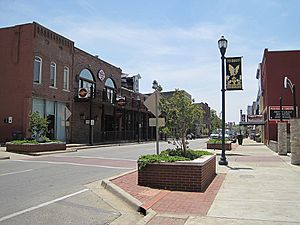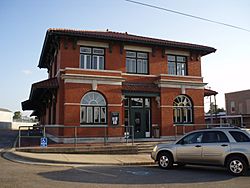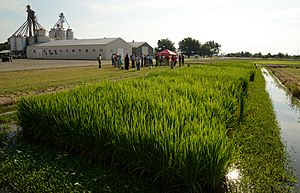Arkansas Delta facts for kids
Bottom: The Delta Cultural Center in Helena-West Helena is operated by the Department of Arkansas Heritage to preserve and interpret the culture of the region.
The Arkansas Delta is one of the six natural regions of Arkansas. It's known for its very fertile land, especially good for growing cotton. Some people even call it "The Deepest of the Deep South" because of its rich history and culture.
This region stretches along the Mississippi River from Eudora in the south up to Blytheville in the north. It goes as far west as Little Rock. The Delta is a flat plain, part of a larger area called the Mississippi Alluvial Plain. This plain is cut through by Crowley's Ridge, which is a narrow line of small hills. These hills rise about 250 to 500 feet (76 to 152 meters) above the flat land. Towns like Jonesboro are built along Crowley's Ridge.
The western edge of the Delta follows the Arkansas River near Little Rock down to Pine Bluff. Then it shifts to Bayou Bartholomew, going south to the Louisiana state line.
The Arkansas Delta has five special areas within it: the St. Francis Basin, Crowley's Ridge, the White River Lowlands, the Grand Prairie, and the Arkansas River Lowlands. Many parts of the Delta are covered by forests that grow in low, wet areas.
The Arkansas Delta includes all of 15 counties, such as Arkansas, Chicot, and Mississippi. It also covers parts of 10 other counties, like Jackson and Jefferson.
Contents
Geography and Land
The Arkansas Delta is divided into five special sub-regions. These are the St. Francis Basin, Crowley's Ridge, the White River Lowlands, the Grand Prairie, and the Arkansas River Lowlands.
The Grand Prairie
The Grand Prairie area has a special layer of clay underground. This clay stops water from soaking in, which made the area a flat grassland. At first, this seemed to slow down growth compared to other parts of the Delta. But in 1897, William Fuller started growing rice, which needs a lot of water, and it worked very well!
Today, growing rice is still a big part of the area's economy and culture. Riceland Foods, the world's largest rice company, is based in Stuttgart, Arkansas on the Grand Prairie.
History of the Delta
Early Times and Settlers
Over thousands of years, many floods from the Mississippi River built up the land in the Delta. In some places, these layers of soil are 100 feet (30 meters) deep!
Long ago, different groups of Native American people lived here. Some built large earth mounds. You can still see these mounds at places like the Nodena Site, Parkin Archeological State Park, and Toltec Mounds Archeological State Park.
When French explorers arrived, they met the Quapaw people living along the Arkansas River. The first European settlement was Arkansas Post, started by Henri de Tonti in 1686. At first, people traded fish and wild game. Later, the fur trade and cutting down trees became important.
Early European settlers came from across the Mississippi River. They often traded with Native Americans. French traders sometimes married Quapaw women, which helped build friendships for trade.
Around 1800, more settlers from the United States moved in. In 1803, the U.S. bought this land from France in the Louisiana Purchase. As settlers cleared land, they moved onto Quapaw lands. This caused problems because the two groups had different ideas about land ownership. Things got worse after a big earthquake in 1812. Some Native Americans thought it was a sign of punishment for trading with Europeans.
A special spot in the Arkansas Delta near Blackton was chosen as the starting point for all land surveys of the Louisiana Purchase. This site is now a National Historic Landmark and is part of Louisiana Purchase Historic State Park. A stone marker, reached by a boardwalk through a swamp, shows this important spot.
Plantations and Changes
Before the American Civil War, American settlers used enslaved African Americans to clear swamps and forests. They built large cotton farms called plantations. Cotton became the main crop grown here.
After Arkansas became a territory in 1819, officials began moving the Quapaw people from their fertile homeland. The Quapaw had lived along the Arkansas River for centuries. They were moved to Louisiana in 1825-1826. They returned to Arkansas by 1830 but were later moved permanently to Oklahoma in 1833.
The invention of the cotton gin made growing cotton very profitable. The rich soil of the Delta was perfect for it. Many enslaved African Americans were brought to the Delta from other states to work on these plantations. By 1860, some Delta counties had more enslaved people than free people. The Civil War ended this period.
After the war, many formerly enslaved people stayed in the area. They often worked as sharecroppers or tenant farmers. This meant they farmed land owned by others and shared the crops. The Delta's economy continued to rely on farming, and wages stayed low.
The 20th Century and Civil Rights
After the Civil War, laws were passed in Arkansas to make it harder for African Americans and poor white people to vote. This included things like requiring secret ballots and making people pay a poll tax. These laws greatly reduced the number of African American voters for many years.
After World War I, tensions grew. In 1919, a terrible event known as the "Elaine Massacre" happened near Elaine, Arkansas. It was caused by local landowners trying to stop African American farmers from forming a union. Many African Americans were killed in this violence.
The Delta also suffered greatly during the Great Mississippi Flood of 1927. This flood put huge areas underwater, damaged many homes, and left many people without a place to live.
In the 1930s, during the Great Depression, a new law helped large cotton farms but hurt sharecroppers. In response, two young Socialists helped form the Southern Tenant Farmers Union. This union brought together farmers of all races. They organized meetings and helped thousands of farmers. In 1935, they went on strike for better wages, and it worked! But the union's power lessened over time.
In the 1940s, machines started doing the work of picking cotton. This meant fewer jobs for people. During World War II, many African Americans moved from Arkansas to places like California for defense jobs. This was part of a movement called the Great Migration. Because of fewer jobs, the Delta's population continued to shrink.
Music of the Delta
The Arkansas Delta is famous for its amazing music. It's known for deep blues and gospel music, but it also has a mix of country music and R&B.
Arkansas blues musicians helped shape every type of blues music, from ragtime to Delta blues and Chicago blues. Many blues pioneers were born or lived in the Arkansas Delta. Cities like Helena and West Memphis had many clubs and dance halls where this music thrived.
Today, the Delta hosts several blues events, including the Arkansas Blues and Heritage Fest. This festival brings in about 85,000 people each day and is one of the top music events in the country!
Gospel music is also very important in the Delta. Many popular artists started by singing in church choirs. Because of the history of segregation, the African American church and its music played a central role in people's lives. Unlike blues, where men were often the main performers, women played a big part in gospel music.
The Arkansas Delta also has deep roots in country music. Famous country artists, including those who play bluegrass and rockabilly, came from this area. This shows how blues and country music are connected.
R&B music also grew out of the strong blues and gospel traditions in the Delta.
Arkansas's blues history is closely linked with Mississippi and Memphis, Tennessee. Many blues masters from Arkansas influenced famous musicians like Muddy Waters, B.B. King, Eric Clapton, and the Rolling Stones. Some notable artists from the Arkansas Delta include Albert King, Howlin’ Wolf, James Cotton, Louis Jordan, and Sister Rosetta Tharpe. Country artists Johnny Cash and Levon Helm were also born and raised here.
The Delta Today

Farming is still the main part of the Arkansas Delta's economy. The biggest crop is cotton, but farmers also grow rice and soybeans. New types of farming, like raising catfish and poultry, have also become important.
The Delta has a low population density, meaning there aren't many people living in a large area. Slightly more than half of the people living here are African American, showing their long history in the region. Over the last 60 years, as farming became more mechanized, many jobs disappeared. People moved away to find work, which has made it harder for the Delta to support schools, roads, and healthcare. Many people who remain in the region face unemployment and poverty.
The Delta Cultural Center in Helena works to protect and share the culture of the Arkansas Delta. The University of Arkansas at Pine Bluff's University and Cultural Museum and the Arts and Science Center for Southeast Arkansas in Pine Bluff also help highlight the region's art and history.
In 2005, there were reports that the ivory-billed woodpecker, a bird thought to be extinct since 1944, was seen in a swamp in eastern Arkansas.
Principal Cities
- Jonesboro
- West Memphis
- Blytheville
- Forrest City
- Helena-West Helena
- Marianna
- Stuttgart
- Newport
- Augusta
- Osceola
- Pine Bluff
Higher Education
- Arkansas State University
- East Arkansas Community College
- Southeast Arkansas College
- Phillips Community College of the University of Arkansas
- University of Arkansas at Pine Bluff
- University of Arkansas at Monticello
Highways
- Interstate 40 - From Brinkley to West Memphis
- Interstate 55 - From West Memphis to Blytheville
- U.S. Highway 278
- U.S. Highway 49
- U.S. Highway 61
- U.S. Highway 62
- U.S. Highway 63
- U.S. Highway 64
- U.S. Highway 65
- U.S. Highway 165
- U.S. Highway 67
- U.S. Highway 70
- U.S. Highway 79
- U.S. Highway 82
Images for kids







